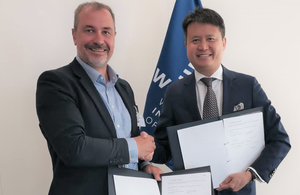UK builds momentum on combat air programme with demonstrator set to fly within five years
- UK develops next generation fighter demonstrator aircraft as part of the Future Combat Air System (FCAS) programme.
- Project involves the Ministry of Defence and the Team Tempest industry partners, led by BAE Systems.
- Comes as the UK deepens collaboration with Japan and Italy as it builds a combat air international partnership.
- FCAS Enterprise launches its ‘Generation Tempest’ initiative creating early careers job opportunities across the UK and a new Tempest Academy.
A new flying demonstrator will be unveiled within the next five years as part of the UK’s major next generation fighter aircraft programme, the Future Combat Air System (FCAS). It comes as the future combat air programme launches a new recruitment and skills initiative known as Generation Tempest, set to create thousands of new job opportunities across the United Kingdom.
The demonstrator aircraft is already in development between the Government and Team Tempest industry partners and the UK is actively progressing collaboration opportunities on the project with Italian industry partners.
The flying demonstrator will be a piloted supersonic aircraft testing a range of new technologies including integration of stealth compatible features. This is the first time the UK will have developed a new fast aircraft using 21st century technology.
Work is rapidly gathering pace on this important part of the FCAS programme, with development of the demonstrator underway at BAE Systems’ facility near Preston in the north of England. This is being supported by hundreds of companies and thousands of engineers across the UK.
The demonstrator is vital for ensuring our technology, skills and industrial capability are ready for the future. Designing and building the flying demonstrator will prove integration and test skills. It will also provide invaluable data and lessons to UK industry to support the introduction of a new FCAS aircraft from 2035.
Separately, the UK is now conducting joint concept analysis with close partners Japan and Italy to understand areas of shared interest and to explore potential Future Combat Air partnership options and continues to explore wider partnerships. Further decisions are expected to be made by the end of 2022. Like the UK, both Japan and Italy operate F-35 fighter jets and the nations have undertaken joint exercises together in the past.
Defence Secretary Ben Wallace said:
I am delighted that the UK, alongside Italy, Japan and Sweden are working on the same combat air journey together.
Our work with Japan and Italy on cutting-edge technologies like this, shows the benefit of our alliances across the world.
The design and development of the demonstrator aircraft represents an important milestone, showcasing the success and talent of our engineers, programmers and software developers. This programme will go on to attract opportunities for many more great minds and talent from across the UK.
To support the programme, a series of measures to attract the brightest minds onto FCAS have been announced, including plans for a new Tempest Academy, joint recruitment and talent development between partners, and the launch of a new careers website. It is hoped that this initiative will create a ‘Generation Tempest’ who will bring their own unique ideas and experiences to the programme.
The FCAS programme plays an important role in supporting the Government’s levelling up ambitions, employing around 2,500 highly skilled people across the UK including at combat air sector industrial hubs in Scotland, the north-west and south-west of England. The programme now employs 1,000 apprentices and graduates, offering attractive employment opportunities in STEM subjects such as industrial digitisation, artificial intelligence and data analytics.
Team Tempest partners, BAE Systems, Rolls-Royce, Leonardo UK and MBDA UK, aim to hire an additional 1,300 early careers starters by the end of 2023.
UK Director Future Combat Air Richard Berthon said:
FCAS is an exciting, dynamic and inclusive programme, needing a diversity of people, ideas and skills working together. We are recruiting fresh talent who will lead FCAS, delivering one of the world’s most important Defence programmes.
The FCAS programme is driving developments at the cutting edge of technology and there have been a series of advances across UK industry supporting the programme, some of which are being showcased at Farnborough Airshow this week including:
- Rolls-Royce Defence has delivered a new gas turbine demonstrator engine, known as Orpheus, designed, built and tested in under two years to prove innovative technology developments for FCAS. Working with international partners, Rolls Royce have also agreed the next stage of the full-scale engine demonstrator programme.
- BAE Systems has used digital transformation to design and build a representative military fast jet fuselage, demonstrating how innovative technologies can transform the design and manufacturing capability for Tempest. Commercial robots were adapted and utilised, and 65% of the parts were guided into location using automation.
- Leonardo UK and Japan’s Mitsubishi Electric have agreed the concept for a radar technology demonstrator called JAGUAR, first unveiled in February, following the completion of joint concept work and feasibility studies earlier this year.
- Leonardo has also revealed ongoing bilateral work to support the future electronics on-board the FCAS programme. Leonardo in the UK and in Italy are working together on a number of projects with Elettronica in Italy including joint assessment of potential architecture of a common Integrated Sensing and Non-Kinetic Effects (ISANKE) and Integrated Communications System. The work is complementary to ongoing collaboration with Japan on 6th generation sensor capabilities, an area in which Italy will soon be involved.
- MBDA unveiled its concept for a weapon effects management system, to aid the coordination of all available weapons in the battle space using Artificial Intelligence and Machine Learning enhanced software.
